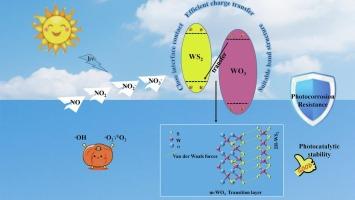In-situ formation of WO3/WS2 heterojunction for an efficient and stable NO abatement under visible light
IF 6.9
2区 材料科学
Q2 CHEMISTRY, PHYSICAL
引用次数: 0
Abstract
Tungsten trioxide (WO3) with a suitable bandgap for environmental photocatalysis exhibits susceptibility to photocorrosion/photochromism stemming from the instability of W6+, which undergoes reduction to lower valence states. To achieve a stable photocatalytic NO abatement, a heterostructure comprising nano-sized tungsten disulfide (WS2) dots on WO3 planar sheets was synthesized via a single-step calcination of WS2 at different temperatures. Charge transfer at the WS2/WO3 interface suppresses the photocorrosion of WO3 during the photocatalytic NO abatement. The optimized WS2/WO3 heterostructure demonstrated an NO removal efficiency that is 2.5 times higher than that of pristine WO3 and exhibited robust stability during cyclic tests. WS2 alone displayed negligible photocatalytic activity toward NO oxidation, but WS2 facilitated the electron diversion on WO3 via a S-scheme mechanism, minimizing the reduction of W6+. The reactive oxygen species (ROS) generated on WS2 has to initiate the oxidation of NO that is activated at the WS2/WO3 interface. This study elucidates a promising methodology for constructing heterostructure with an intimate interfacial contact and an optimized charge transfer for the efficient oxidation of NO under the ambient atmosphere.


原位形成WO3/WS2异质结,在可见光下实现高效稳定的NO消减
具有适合环境光催化带隙的三氧化钨(WO3)由于W6+的不稳定性而表现出光腐蚀/光变色的敏感性,从而使W6+还原到更低的价态。为了实现稳定的光催化脱硝效果,采用不同温度下的单步煅烧方法,在WO3平面片上合成了由纳米二硫化钨(WS2)点组成的异质结构。在光催化氧化过程中,WS2/WO3界面的电荷转移抑制了WO3的光腐蚀。优化后的WS2/WO3异质结构对NO的去除率是原始WO3的2.5倍,且在循环试验中表现出良好的稳定性。单独WS2对NO氧化的光催化活性可以忽略不计,但WS2通过S-scheme机制促进了WO3上的电子转移,使W6+的还原最小化。WS2上产生的活性氧(ROS)必须启动在WS2/WO3界面上激活的NO的氧化。本研究阐明了一种很有前途的方法,用于构建具有密切界面接触和优化电荷转移的异质结构,以在环境气氛下有效氧化NO。
本文章由计算机程序翻译,如有差异,请以英文原文为准。
求助全文
约1分钟内获得全文
求助全文
来源期刊

Applied Surface Science
工程技术-材料科学:膜
CiteScore
12.50
自引率
7.50%
发文量
3393
审稿时长
67 days
期刊介绍:
Applied Surface Science covers topics contributing to a better understanding of surfaces, interfaces, nanostructures and their applications. The journal is concerned with scientific research on the atomic and molecular level of material properties determined with specific surface analytical techniques and/or computational methods, as well as the processing of such structures.
 求助内容:
求助内容: 应助结果提醒方式:
应助结果提醒方式:


